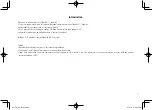
99
atmosphere and obey all signs and instructions. Sparks in such areas could
cause an explosion or fire resulting in bodily injury or even death. Areas
with a potentially explosive atmosphere are often, but not always, clearly
marked. They include fueling areas such as gas stations; below deck on
boats; fuel or chemical transfer or storage facilities; vehicles using liquefied
petroleum gas (such as propane or butane); areas where the air contains
chemicals or particles, such as grain, dust, or metal powders; and any
other area where you would normally be advised to turn off your vehicle’s
engine.
PRECAUTIONS
Your Handheld Portable Telephone is a high quality piece of equipment.
Before operating, read all instructions and cautionary markings on (1)
AC/DC Travel Adaptor (2) Battery and (3) Product Using Battery. Failure to
follow the directions below could result in serious bodily injury and/or
property damage due to battery liquid leakage, fire or rupture.
z
DO NOT use this equipment in an extreme environment where
high temperature or high humidity exists.
z
DO NOT abuse the equipment. Avoid striking, shaking or shocking.
When not using, lay down the unit to avoid possible damage due
to instability.
z
DO NOT expose this equipment to rain or spilled beverages.
z
DO NOT use unauthorized accessories.
z
DO NOT disassemble the phone or its accessories. If service or
repair is required,
z
return unit to an authorized PCD cellular service center. If unit is
disassembled, the risk of electric shock or fire may result.
z
DO NOT short-circuit the battery terminals with metal items etc.
SAFETY INFORMATION FOR FCC RF EXPOSURE
WARNING! READ THIS INFORMATION BEFORE USING
CAUTIONS
In August 1996 the Federal Communications Commission (FCC) of the
United States with its action in Report and Order FCC 96-326 adopted an
updated safety standard for human exposure to radio frequency
electromagnetic energy emitted by FCC regulated transmitters. Those
guidelines are consistent with the safety standard previously set by both
U.S. and international standards bodies. The design of this phone complies
with the FCC guidelines and these international standards.
BODY-WORN OPERATION
This device was tested for typical body-worn operations with the back of
the phone kept
2
cm. from the body. To maintain compliance
requirements, use only belt-clips, holsters or similar accessories that
maintain a
2
cm separation distance between the user’s Body and the
back of the phone, including the antenna. The use of belt-clips, holsters
and similar accessories should not contain metallic components in its
assembly. The use of accessories that do not satisfy these requirements
may not comply with FCC RF exposure requirements, and should be
avoided
Note:
For more information about RF exposure, please visit the FCC
website at
www.fcc.gov
.
SAR INFORMATION
MODEL PHONE MEETS THE GOVERNMENT’SREQUIREMENTS FOR
EXPOSURE TO RADIO WAVES.
Summary of Contents for Verizon TXT8030
Page 1: ...1 Pivot User Guide TXT8030...











































